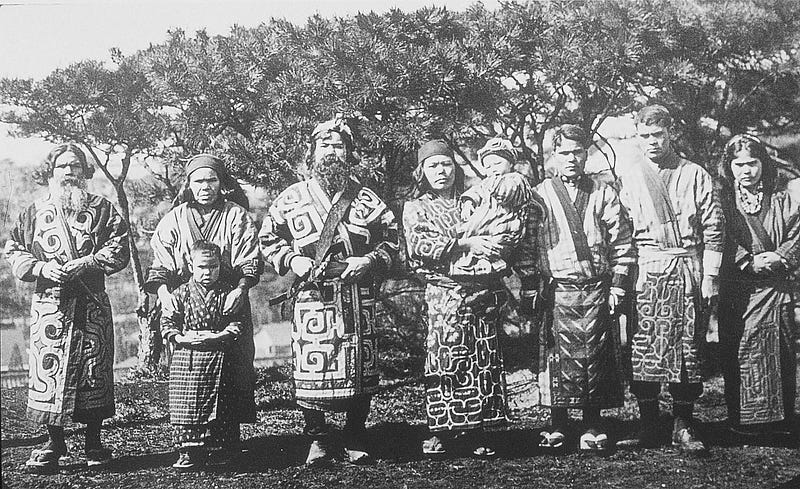Japan’s Latest Punch in the Face to the Ainu People | Olympics 2020

A list of punches delivered to the Ainu people by the Japanese ‘wajin’ government throughout history.
Olympic organisers have dropped the Ainu’s participation from the opening ceremony of this year’s Summer Games. They were told there wasn’t room to fit the dance into the July 24th performance, Kazuaki Kaizawa, an official at the Hokkaido Ainu Association in Sapporo tells The Japan Times.
“We had been preparing and it is a disappointment, but we hope there will still be a chance for us to show Ainu culture elsewhere.”
Officials at the Tokyo 2020 Organising Committee did not immediately respond to a request for comment.

Excluding the Ainu from the Olympics is just the latest of disrespectful and discriminatory punches the Japanese government has dished out throughout history. Past laws and initiatives implemented eliminated the traditional systems of Ainu, their land rights and their language.
Today, there are only two native Ainu speakers worldwide, according to the Endangered Languages Project, an organisation of indigenous groups and researchers aimed at protecting endangered languages, (CNN).
The Ainu, like other minority groups in Japan, was an inconvenient culture at a time when the government was steadfastly creating a national myth and rhetoric. Japanese government officials and academics have tried to hide them in a desperate attempt to keep up a facade of a homogenous nation with one mind and heart. So officials tucked the Ainu into files marked “human migration mysteries,” or “aberrant hunter-gatherers of the modern age,” or “lost Caucasoid race,” or “enigma,” or “dying race,” or even “extinct.”
Indigenous peoples in Japan include Ryūkyūans (including Okinawans; around 1,400,000) and Ainu (estimated at 24,000 people). The Ainu are said to be Japan’s first people, Hokkaido’s ground containing continuous layers of occupation that date back as far as 3,000 years before present.

It is stipulated in some documentaries and articles that Japan had officially acknowledged the Ainu as an indigenous people in 2007, but in reality, did not do this until as late as 2019. In September 2007, Japan did vote in favour of the United Nations Declaration on the Rights of Indigenous Peoples. In the same month, however, lawmaker Muneo Suzuki submitted a question to the government asking whether Japan’s adoption of the U.N. declaration technically meant it acknowledged the Ainu were the indigenous people of Japan. The government replied that it could not answer the question because the U.N. did not define what qualifies as an “indigenous people.” Additionally, they found it difficult to qualify who would be included under the proposed new bill and policies, (Japan Times)
The irony lies in the fact that previous assimilation programmes initiated by the Japanese government are what caused the distinction of Ainu heritage to be blurred.
History of Discrimination and Exclusion of the Ainu People
- Discriminatory trade control in the 14th-18th century
In the early history of Japan, when the wajin or ethnically Japanese moved North, they depicted the Ainu as demons (Oni) and branded them as foreigners, promoting discrimination against them. With time they instated unfair or abusive trading rules and took advantage of Ainu resources. This continued for centuries, and eventually lead to the wajin crack down harder on the “rebellious” Ainu with forced assimilation. - Victimisation of the Ainu between Russia and Japan in the 19th century
The land that the Ainu originally called home stretched between Japanese and Russian territory. Through political antics, the Japanese and the Russian agreed on borders in the Treaty of Shimoda (1855). Later, after the Meiji Restoration (1869) the Japanese government included what would later be known as Hokkaido along with the Kuril islands into their sovereignty, and allowed Russia to keep Sakhalin. Ainu people were given a choice to choose their citizenship, while both masters did not treat them well in their new environments. - The development of the nation of Japan into Hokkaido (1869~1882)
After the annexing of Hokkaido as Japanese territory, the government sent people to survey and create plans for their new land. They did studies on the geography and resources but paid little attention to the already existing Ainu and their way of life.
“For the sake of Japan’s own development, our traditions and culture were ignored” (The Ainu Association of Hokkaido). - Ethnic cleansing of the Ainu people (1871)
The Census Act in 1871 forced Ainu people to be registered under Japanese last names. Simultaneously, their language, culture, traditions and way of life was prohibited. Some Ainu traditions were extremely contrasting with Japan’s predominant culture for example, women would put tattoos on their faces before marriage and men would get traditional piercings. This proliferated the stigmas towards Ainu people. “For the Ainu people, this act was an assimilation policy of ethnic cleansing” (Okada 5). - Providing favourable conditions for Japanese to start businesses in Hokkaido, excluding the Ainu (Late 19th century)
The central government aimed to promote emigration into Hokkaido to develop the area further with “The Immigrant Support Rules” in 1869. Around the same time, they also instated the “Property Law” and a little later, the Hokkaido Undeveloped Land Allocation Law (1897) to seize Ainu land and give it to business owners and corporations. These “immigrants” also received breaks and support for expenses such as travel, housing, food and farming tools. Naturally, none of these benefits were extended to the Ainu. - The Hokkaido Former Aborigine Protection Act
For the purpose of promoting farming in Hokkaido, this act allocated land allowance to families willing to try their hand at farming. The Ainu livelihood, however, largely depended on fishing and hunting. This act also set a quota so that the land given would be taken away if no success could be proved within fifteen years. Most of the Ainu people, who were not used to farming, did not succeed in their attempts. Those who failed at farming were sent to factories and mines, where they worked as poorly-paid labourers (Uemura, 2008, Ainu Minzoku Hakubutsukan, 1993). Prior to this act, their traditional fishing and hunting activities were banned by the government in order to promote farming and controlled production. - Pledged to create a new law to help the Ainu recover their status and regain their culture in 2008; doesn’t do so until 2019.
Lastly, after voting for better treatment for indigenous peoples at the UN conference in 2007, Japan took a total of 12 years to merely identify the Ainu as an indigenous people of Japan through legislature. We are still yet to see the effects of this new bill, and there is backlash towards some of its contents (for example, turning their lands and culture into an exhibit risks further segregation from the human needs of the Ainu).
Although the law was enacted amid a rise in global awareness about promoting and protecting minority rights, it does not stipulate rights to self-determination and education for the Ainu despite both rights being acknowledged in the 2007 U.N. declaration on the rights of indigenous people.
Removing the Ainu performance from the Olympics may seem like a harmless action, but is actually proliferating a long history of exclusion and disregard for the Ainu claim to Japan’s heritage.
Sources:
Journal of Indigenous Social Developments: https://scholarspace.manoa.hawaii.edu/bitstream/handle/10125/21976/v1i1_02okada.pdf
CNN:
https://edition.cnn.com/2019/04/20/asia/japan-ainu-indigenous-peoples-bill-intl/index.html
Straitstimes:
https://www.straitstimes.com/asia/east-asia/japan-to-recognise-indigenous-ainu-people-for-first-time
No spam, no sharing to third party. Only you and me.






